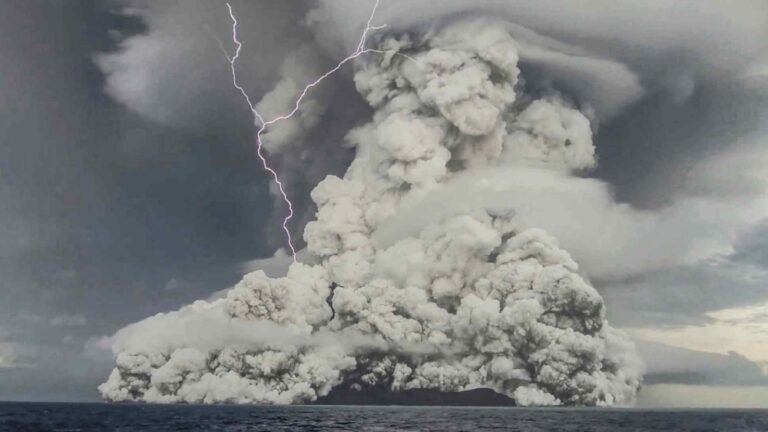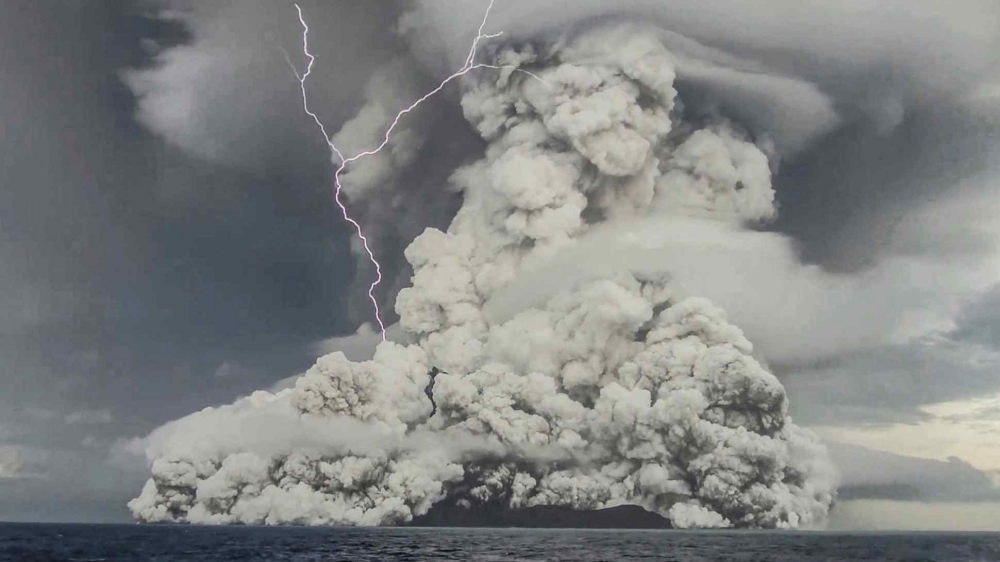
[ad_1]

2022 started off with a literal bang. The eruption of Hunga Tonga-Hunga Ha’apai was one of the most powerful blasts in decades, with some evidence that the plume it produced reached space. As impressive as the Tongan eruption might be, it was part of the normal volcanic activity our planet experiences each year. So, just how volcanically active is the planet?
I get a lot of questions about whether volcanic activity on Earth is increasing. Sometimes it can feel that way, especially when a big eruption makes the headlines and people begin to notice other volcanoes. Just last month, Mauna Loa In Hawai’i began erupting again for the first time in almost 40 years. When people discovered that Kīlauea, right next door to Mauna Loa, was erupting at the same time, there was always a question about whether this was normal. Based on the record of volcanism on the Big Island, we know that it is!
Mauna Loa erupting on December 8, 2022. Credit: USGS/HVO.
Thankfully, we don’t have to use anecdotal evidence to show that we aren’t on an increasingly active planet. The Smithsonian Institute and USGS Global Volcanism Program documents all the known volcanic activity worldwide. Their database spans hundreds of thousands of years. They also put together a weekly rundown of the volcanism across the globe each week. It is a treasure trove of volcanic goodness.
According to the latest census of volcanic activity put together by the GVP, there are 44 current eruptions ongoing. I bet most people are surprised by that number. The media rarely covers most of this activity unless it is big, unexpected, deadly or damaging. That’s just how the news media works. So, lava flows at a remote Alaskan volcano like Great Sitkin don’t make the headlines.
How Many Eruptions?
Over the course of 2022, the GVP has documented 82 eruptions (on 78 volcanoes). Of those, 31 were eruptions than began this year, another 38 ended (some of which could have started this year) and the balance are eruptions that will continue into 2023.
In 2021, that number was 80 eruptions (on 75 volcanoes), with 33 new eruptions, 29 eruptions ending. Looking at 2020, it was 72 (on 67 volcanoes), 27 new, 25 ending. You begin to get the idea. The number is remarkably steady when you look over the past 20 years.
Taking the numbers kept by the GVP for eruptions since 1960, maybe we can see a pattern there:
Chart showing eruptions since 1960, with (top to bottom) active volcanoes, total eruptions, new eruptions and eruptions ending. A trend line is shown for each value. Credit: Erik Klemetti with data from Global Volcanism Program, 2022. [Database] Volcanoes of the World (v. 5.0.1; 19 Dec 2022). Distributed by Smithsonian Institution, compiled by Venzke, E.
Interesting! At first glance, the trend line since 1960 for active volcanoes and eruption does go up a bit. New eruptions starting each year is flat and eruptions ending is slightly upward.
Two hypotheses fall out of this. The first one might be that volcanic activity is increasing. The second might be that our awareness of volcanic activity is increasing. How could we figure this out?
Comparing the Size of Eruptions
We rank volcanic eruptions using the Volcanic Explosivity Index. It is a crude tool that compares the volume of material produced in an eruption. It was developed to compare explosive volcanic eruptions, so ones that produce mostly lava flows awkwardly fit into this index, usually referred to as VEI. Eruptions that fall in the VEI 0-3 are relatively small and happen frequently. For example in 2021, 30 of the 80 eruptions documented by the GVP were VEI 2. Eruptions VEI 4 and larger are much less common, with only one VEI 6 eruption in the past 60 years.
If you want to argue that volcanic activity is increasing, you might expect that all types of eruptions are increasing. So, what happens if we plot eruptions by VEI (note: the GVP database sorts as VEI 2, 3, 4, 5 and 6+)
Volcanic eruptions each year sorted by their volcanic explosivity index (VEI), with VEI 2 (top), VEI 3 (middle), VEI 4 (bottom). VEI 5 and above are not included because of their scarcity since 1960. Credit: Erik Klemetti with data from Global Volcanism Program, 2022. [Database] Volcanoes of the World (v. 5.0.1; 19 Dec 2022). Distributed by Smithsonian Institution, compiled by Venzke, E.
So, the trend lines for eruptions since 1960 are pretty flat, especially for eruptions above VEI 2. This is something that Ed Venzke at the GVP has noted for the longterm volcanic activity database reaching back hundreds to thousands of years. The total number of eruptions looks like it is increasing, but the number of larger eruptions have remained flat.
The conclusion that Venzke draws from that is we are just better at noticing eruptions. Big eruptions are much more noticeable from further away, so they get added to the record. Before 1980, small eruptions below VEI 2 might only be noted if someone was standing right near the volcanic at the right time.
If we take the GVP data one more step, we can really see this.
The number of eruptions by year, with those that would rank at VEI 0-1 on top and VEI 2 or greater above. Credit: Erik Klemetti with data from Global Volcanism Program, 2022. [Database] Volcanoes of the World (v. 5.0.1; 19 Dec 2022). Distributed by Smithsonian Institution, compiled by Venzke, E.
Look at that! Eruptions larger than VEI 2 are nearly flat while eruptions that are VEI 0-1 have a clear upward slope (increase) since 1960. The best explanation for this is we have just been able to document more of these small eruptions. We’re noticing more eruptions, but the total number of eruptions is not increasing.
We Just See a Lot More
We can thank a few major innovations for this ability to “see” more eruptions. The tools of volcano monitoring — seismometers to record earthquakes, GPS to record changes in shape, webcam (both visual and infrared), infrasound to record the deep booms of eruption — have become better, more common and widely used. We can keep track of individual volcanoes more closely and more countries have invested in volcano monitoring to protect people living near active volcanoes.
The global network of Earth-observing satellites is the other advancement. Back in 1980, only a handful of weather satellites were able to capture the eruption of Mount St. Helens. Today, thousands of government and private satellites scour the entire surface of the Earth on a daily basis. Those eruptions at remote volcanoes like Great Sitkin or Mount Michael in the Indian Ocean are noted and recorded, adding to our database.
The upshot of this is that eruptions that kill thousands of people are much rarer now than in the past. All this information about volcanic unrest means that geologists monitoring volcanoes can give good advice to crisis managers, allowing people to get out safely.
It might be exciting to some to think that the Earth is becoming more active, geologically at least. Climate change is making destructive weather events more common over the past quarter century. Thankfully, volcanoes have not (and will not) follow suit. Instead, we just have a lot of eyes (and instruments) on eruptions around the planet.
[ad_2]